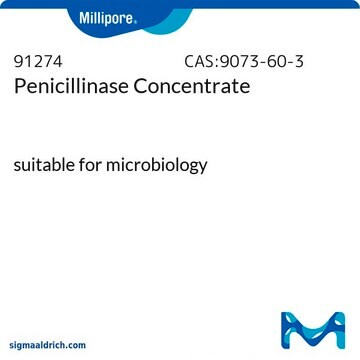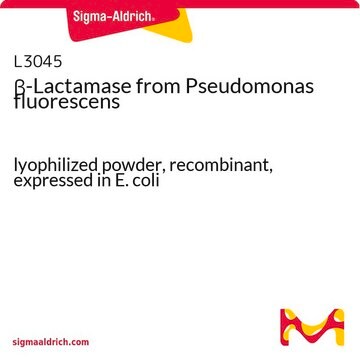426205
β-Lactamase, Bacillus cereus 569/H9
Synonyme(s) :
β-Lactamase, Bacillus cereus 569/H9, Penicillinase
About This Item
Produits recommandés
Source biologique
Bacillus sp. (Bacillus cereus)
Niveau de qualité
Forme
lyophilized
Conditionnement
vial of ≥50 units β-lactamase II
vial of ≥500 units β-lactamase I
Fabricant/nom de marque
Calbiochem®
Conditions de stockage
OK to freeze
Solubilité
sterile distilled water: soluble
Conditions d'expédition
ambient
Température de stockage
−20°C
Description générale
Actions biochimiques/physiologiques
Avertissement
Définition de l'unité
Reconstitution
Informations légales
Mention d'avertissement
Danger
Mentions de danger
Conseils de prudence
Classification des risques
Resp. Sens. 1 - Skin Sens. 1
Code de la classe de stockage
11 - Combustible Solids
Classe de danger pour l'eau (WGK)
WGK 3
Point d'éclair (°F)
Not applicable
Point d'éclair (°C)
Not applicable
Certificats d'analyse (COA)
Recherchez un Certificats d'analyse (COA) en saisissant le numéro de lot du produit. Les numéros de lot figurent sur l'étiquette du produit après les mots "Lot" ou "Batch".
Déjà en possession de ce produit ?
Retrouvez la documentation relative aux produits que vous avez récemment achetés dans la Bibliothèque de documents.
Les clients ont également consulté
Notre équipe de scientifiques dispose d'une expérience dans tous les secteurs de la recherche, notamment en sciences de la vie, science des matériaux, synthèse chimique, chromatographie, analyse et dans de nombreux autres domaines..
Contacter notre Service technique










